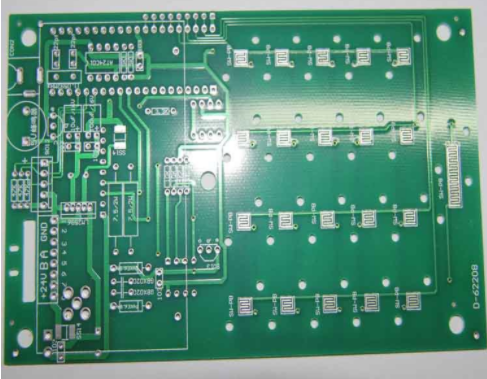Circuit board corrosion method
The corrosive liquid is generally made up of ferric chloride and water. The ferric chloride is a khaki solid and is easy to absorb moisture in the air, so it should be sealed and stored. When preparing the ferric chloride solution, 40% ferric chloride and 60% water are generally used, of course, more ferric chloride, or warm water (not hot water to prevent the paint from falling off) can make the reaction faster Note that ferric chloride is corrosive, it is best not to get it on the skin and clothes (difficult to wash:-(The reaction container uses a cheap plastic basin, just fit the circuit board. The corrosion is from the edge At the beginning, when the unpainted copper foil is corroded, the circuit board should be taken out in time to prevent the paint from peeling off and corroding the useful circuit. At this time, rinse with water, and scrape off the paint with bamboo chips by the way (at this time, the paint It is easier to remove from the liquid.) If it is not easy to scratch, just rinse it with hot water. Then wipe it dry and polish it with sandpaper. The shiny copper foil is exposed, and a printed circuit board is ready. In order to save the results, Bitbaby usually coats the polished circuit board with a rosin solution, which can not only assist soldering, but also prevent oxidation. The method of making circuit boards under amateur conditions. Overview The circuit board is the carrier of the electronic circuit, and any circuit design is required Its function can be realized only when it is installed on a circuit board. And processing circuit boards is the most headache for hobbyists. It is often: the circuit is designed in half a day, but it takes a few minutes to process the circuit board. Days. Even some very good circuit design ideas have given up the experiment because it takes too much time to process the circuit board and can’t continue to realize it. The webmaster began to do circuit experiments more than 20 years ago, and the most confusing thing is to make circuit boards. It can be said that I have tried everything: paint, paraffin, carbon paper, carving knives, and even the nail polish and eyebrow pencils used by MM have been used, and they still cannot achieve the purpose of efficient and high-quality production of experimental circuit boards. .

Later, when I went to the company to engage in professional design and development, I realized that professional engineers didn't even know that there were such difficulties. They use CAD to design the drawings, print them out and submit them to the PCB processing factory, and several PCB samples can be processed in a few days. Install the parts, debug and modify them, print them, and send them to the PCB processing factory for processing. Repeat a few times to complete the circuit. They don't have to consider all kinds of cumbersome processes and production costs in the process of processing circuit boards. The reason why PCB processing plants have to tire of repeatedly processing experimental circuit boards for these companies for free is of course not "carrying forward the Leifeng spirit." Obviously, these processing costs are to be allocated to the future mass production costs.
If you are a small, unknown company, or an individual, the cost of processing may cost hundreds of yuan. Therefore, how to process circuit boards for experiments in a simple, fast, low-cost, and high-quality manner is a topic worthy of research. Now there are many new good methods, such as: thermal transfer method, pre-coated photosensitive copper-clad production method, hot melt plastic film method and so on. This site will collect the methods and experience in this area, organize them into articles, and publish them on this site one after another. Enthusiasts, manufacturers, material and equipment suppliers, etc. are also welcome to cooperate, or write articles, provide your products, or cooperate in sales.
As mentioned in the preface, the circuit board is the carrier of the circuit, and we usually call it "printed circuit board" by the abbreviation "PCB". Formal production of printed circuit boards is naturally related to printing. The screen printing process is usually used. The basic process is as follows: Design layout - Tracing - Exposure (making printing master) - Printing - Chemical corrosion - Cleaning and surface treatment - Printing assistance Welding, marking, solder mask and other layers - cutting, punching and other mechanical processing - finished circuit board
Under amateur conditions, the process of "printing flux, marking, solder mask, etc." can be omitted, and the difficulty lies in the plate-making and printing links. Since only a small amount (one or several pieces) of circuit boards need to be produced, it is obviously uneconomical to adopt formal plate making and printing procedures, so there are various non-printing or sub-printing production methods.